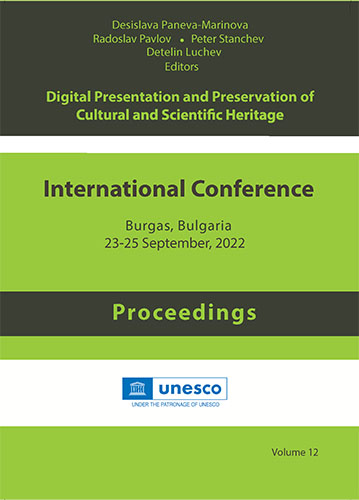Digitization of Cultural Heritage of Burgas Region, Bulgaria - Initiatives and Outcomes
DOI:
https://doi.org/10.55630/dipp.2022.12.24Keywords:
Digitalization, Cultural Heritage, Intangible Cultural Heritage, Virtual Exhibition, Digital CollectionAbstract
The purpose of this article is to present some of the most significant initiatives related to the digitalization of tangible and intangible cultural heritage of the Burgas region, Bulgaria. The described achievements and outcomes related to the digital promotion, presentation, and preservation of cultural heritage of the region in global and long-term perspectives are a result of the fruitful cooperation at the national and international level of experts in digitization from research institutes and organisations with faculty staff from higher education institutions and professionals from cultural and creative industry domain from Bulgaria and abroad.References
DigiCult . (n.d.). Retrieved from Digital presentation and preservation of intangible cultural heritage: https://www.digicultproject.eu/en/
EURICA . (n.d.). Retrieved from Europe Ritual Cuisine – Digital Presentation and Preservation: https://eurica.eu/#
European Commission. (2018). A New European Agenda for Culture, COM(2018) 267 final. Retrieved from https://eur-lex.europa.eu/legalcontent/EN/TXT/HTML/?uri=CELEX:52018DC0267&from=EN#footnote5
Monova-Zheleva, M., Zhelev, Y., & Nikolova, E. (2020). Intangible Cultural Heritage Presentation and Preservation - Callenges and Opportunities for Museum Specialists. Digital Presentation and Preservation of Cultural and Scientific Heritage (pp. 233-240). IMI-BAS.
Nikolova, E., Zhelev, Y., & Monova-Zheleva, M. (2021). Cultural Heritage and Interoperability in the Context of Competencies of the Culture Industry Human Resources. Digital Presentation and Preservation of Cultural and Scientific Heritage (pp. 151-158). IMI-BAS.
ORCHIS . (n.d.). Retrieved from Research, Conservation and Habitats of Orchids in Strandzha Project: http://www.orchis.onenat.org
Paneva-Marinova, D., Goynov, M., & Luchev, D. (2017). Multimedia digital library: constructive block in ecosystems for digital cultural assests. Basic functionality and services. Berlin: LAP LAMBERT.
Stewart, R., Monova-Zheleva, M., Zhelev, Y., Pavlova, L., Luchev, D., Paneva- Marinova, D., & Pavlov, R. (2017). The Orthodox icons collection of the Regional Historical Museum—Burgas: A digital library for iconographic objects. Digital Presentation and Preservation of Cultural and Scientific Heritage (pp. 157–172). Veliko Tarnovo: Institute of Mathematics and Informatics, Bulgarian Academy of Sciences.
Stewart, R., Zhelev, Y., & Monova-Zheleva, M. (2018). ORCHIS - technology in help of botanists and foresters on both sides of the border. Digital Presentation and Preservation of Cultural and Scientific Heritage (pp. 225-240). IMI-BAS.
Zhelev, Y. (2018). Multimedia Libraries: Standards, Methods and Models. InformaPrint, ISBN978-619*7252-41-5.
Zhelev, Y., Monova-Zheleva, M., & Stewart, R. (2021). The Digital Future of Intangible Cultural Heritage – Challenges and Initiatives. Digital Presentation and Preservation of Cultural and Scientific Heritage (pp. 41-50). IMI-BAS.
Zhelev, Y., Stewart, R., & Monova-Zheleva, M. (2021). Development of Digital Collections of Intangible Cultural Heritage Objects - Base Ontology. Digital Presentation and Preservation of Cultural and Scientific Heritage (pp. 51-56). IMI- BAS.




